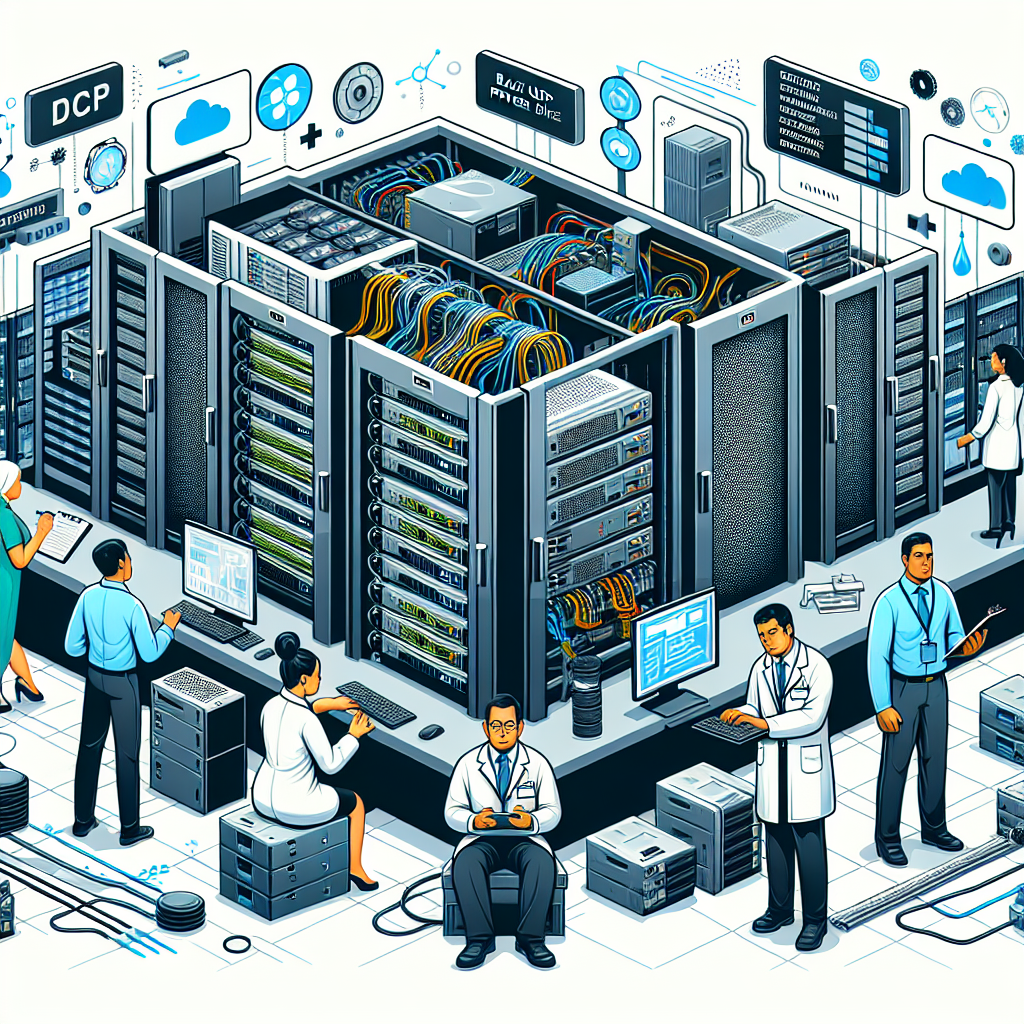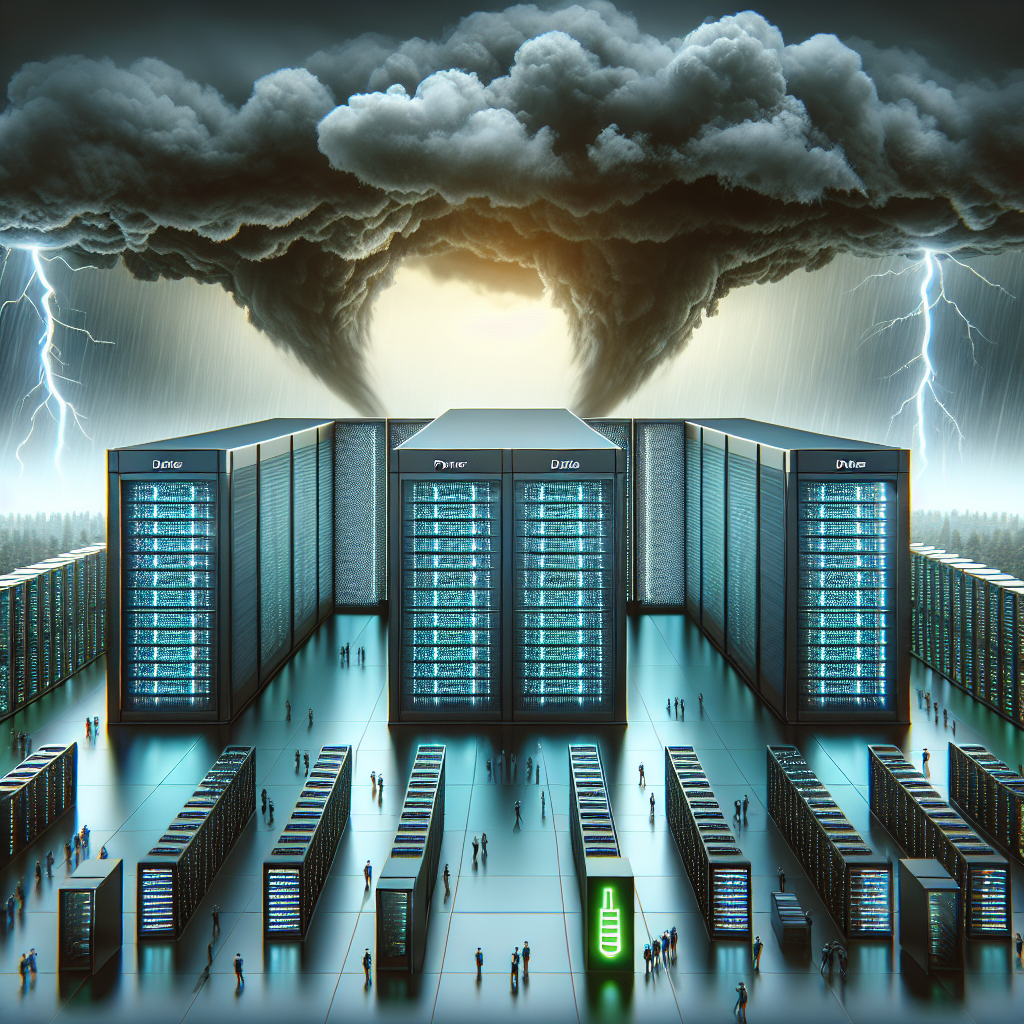Your cart is currently empty!
Tag: Crisis

From Disaster to Recovery: How to Rebuild and Restore Operations After a Crisis
In the business world, crises can strike at any moment, causing chaos and disruption to operations. From natural disasters to cyberattacks to pandemics, companies must be prepared to handle unexpected events that can threaten their ability to function. In the aftermath of a crisis, it is crucial for organizations to have a plan in place to rebuild and restore operations in order to minimize the impact on their bottom line and reputation.The first step in recovering from a crisis is to assess the damage and determine the extent of the impact on the business. This may involve conducting a thorough review of the situation, gathering information from key stakeholders, and assessing the financial and operational implications of the crisis. Once the extent of the damage is understood, companies can begin to develop a recovery plan that outlines the steps needed to restore operations and get back on track.
One of the key components of a successful recovery plan is communication. Companies must be transparent with their employees, customers, and other stakeholders about the situation and the steps being taken to address it. This can help to rebuild trust and confidence in the organization, which is crucial for maintaining relationships and reputation in the long term.
Another important aspect of rebuilding and restoring operations after a crisis is to prioritize critical functions and resources. This may involve identifying key processes and systems that are essential for the business to operate and focusing on restoring them first. By prioritizing critical functions, companies can ensure that they can continue to serve their customers and meet their obligations even in the midst of a crisis.
In addition to prioritizing critical functions, companies should also focus on strengthening their resilience and preparedness for future crises. This may involve implementing new policies and procedures, investing in technology and infrastructure, and training employees to respond to emergencies effectively. By taking proactive steps to improve resilience, companies can minimize the impact of future crises and ensure that they are better prepared to handle unexpected events.
Ultimately, recovering from a crisis requires a combination of resilience, communication, and strategic planning. By developing a recovery plan, prioritizing critical functions, and investing in resilience, companies can rebuild and restore operations after a crisis and emerge stronger and more prepared for the future. By learning from past experiences and taking proactive steps to improve preparedness, businesses can ensure that they are able to weather any storm and continue to thrive in the face of adversity.

The Importance of Business Continuity Planning in Times of Crisis
In times of crisis, such as natural disasters, cyber attacks, or pandemics, businesses can face significant challenges that threaten their operations and profitability. It is during these difficult times that the importance of business continuity planning becomes evident.Business continuity planning is the process of creating a roadmap that outlines how a business will continue to operate during and after a crisis. It involves identifying potential risks and developing strategies to mitigate them, ensuring that essential functions can continue even when faced with disruptions.
One of the key reasons why business continuity planning is crucial in times of crisis is that it helps organizations to minimize downtime and maintain business operations. By having a plan in place, businesses can quickly respond to unexpected events and implement measures to ensure that critical processes are not disrupted. This can help to prevent financial losses and preserve the reputation of the company.
Additionally, business continuity planning can help to protect the safety and well-being of employees. By having procedures in place for emergencies, businesses can ensure that their employees know what to do in the event of a crisis, reducing the risk of injury or harm.
Furthermore, having a business continuity plan can also help to build trust and confidence among customers, suppliers, and other stakeholders. When a business is able to demonstrate that it has measures in place to address potential risks, it can reassure stakeholders that it is prepared to weather any storm and continue to deliver products and services as promised.
In conclusion, business continuity planning is a critical aspect of risk management that can help businesses navigate through times of crisis. By identifying potential risks, developing strategies to mitigate them, and ensuring that essential functions can continue, businesses can protect their operations, employees, and reputation. Investing in business continuity planning is an investment in the long-term success and sustainability of a business.

From Crisis to Opportunity: Leveraging Business Continuity Planning for Long-Term Success
In the face of unexpected crises and disruptions, businesses must be prepared to adapt and thrive in order to survive. One crucial tool for navigating these challenges is a comprehensive business continuity plan.A business continuity plan is a proactive strategy that outlines how an organization will continue to operate during and after a disruption. This plan not only helps businesses weather the storm during a crisis, but also positions them for long-term success by enabling them to quickly recover and resume normal operations.
From natural disasters to cyber attacks, there are a myriad of potential threats that can disrupt business operations. By developing a business continuity plan, organizations can identify these risks and create strategies to mitigate their impact. This proactive approach not only helps minimize downtime and financial losses during a crisis, but also builds resilience and agility within the organization.
Moreover, a business continuity plan can also help companies identify new opportunities for growth and innovation. By analyzing potential threats and vulnerabilities, businesses can uncover areas for improvement and innovation within their operations. For example, a company that experiences a cyber attack may use the incident as an opportunity to upgrade their cybersecurity measures and enhance their overall IT infrastructure.
Furthermore, having a business continuity plan in place can also help build trust and confidence among stakeholders, including customers, employees, and investors. Knowing that a company has a plan in place to deal with disruptions can instill a sense of security and reliability, ultimately enhancing the organization’s reputation and credibility in the market.
In conclusion, business continuity planning is not just about surviving a crisis – it’s about leveraging challenges as opportunities for growth and long-term success. By investing time and resources into developing a comprehensive business continuity plan, organizations can not only weather the storm during times of crisis, but also position themselves for resilience, innovation, and success in the long run.

From Crisis to Recovery: Navigating Data Center Disasters with Confidence
In today’s digital age, data centers play a critical role in the operations of businesses and organizations. They store and manage vast amounts of data, ensuring that important information is always accessible and secure. However, despite their importance, data centers are not immune to disasters. From natural disasters like floods and earthquakes to man-made incidents like cyberattacks and power outages, data centers face a variety of threats that can disrupt their operations and put sensitive information at risk.In the face of such challenges, it is crucial for data center managers to have a comprehensive disaster recovery plan in place. This plan should outline the steps to be taken in the event of a disaster, ensuring that data can be quickly recovered and operations can be restored as soon as possible. From crisis to recovery, navigating data center disasters with confidence requires a strategic approach and a proactive mindset.
One key aspect of disaster recovery planning is data backup and storage. Regularly backing up data to offsite locations or cloud storage ensures that even in the event of a disaster, critical information can be recovered. Additionally, implementing redundant systems and failover mechanisms can help ensure that operations can continue even if one part of the data center fails.
Furthermore, maintaining strong cybersecurity measures is essential to protecting data centers from cyberattacks. Regularly updating software, implementing firewalls, and conducting security audits can help prevent breaches and unauthorized access to sensitive information. In the event of a cyberattack, having a response plan in place can help minimize the damage and quickly restore operations.
It is also important for data center managers to regularly test and update their disaster recovery plans. Conducting drills and simulations can help identify any gaps or weaknesses in the plan and ensure that all staff are prepared to respond effectively in the event of a disaster. Additionally, as technology and threats evolve, it is important to regularly review and update the disaster recovery plan to ensure its effectiveness.
Ultimately, navigating data center disasters with confidence requires a proactive and strategic approach. By implementing strong cybersecurity measures, regularly backing up data, and testing and updating disaster recovery plans, data center managers can ensure that their operations are resilient in the face of any disaster. With a comprehensive plan in place, businesses and organizations can navigate crises with confidence and quickly recover from any disruptions to their data center operations.

How Data Center Disaster Recovery Can Save Your Business in Times of Crisis
In today’s digital age, businesses rely heavily on data to operate efficiently and effectively. From customer information to financial records, data is the lifeblood of modern organizations. However, all it takes is one unexpected disaster to potentially wipe out years’ worth of data and cripple a business.This is where data center disaster recovery comes into play. A data center disaster recovery plan is a comprehensive strategy that outlines how an organization will recover and restore its data in the event of a disaster, such as a cyberattack, natural disaster, or hardware failure. By having a solid disaster recovery plan in place, businesses can minimize downtime, protect their data, and ensure business continuity in times of crisis.
One of the key benefits of having a data center disaster recovery plan is the ability to quickly recover and restore data. In the event of a disaster, businesses can rely on their disaster recovery plan to guide them through the process of recovering and restoring their data. This can help minimize downtime and ensure that critical business operations can resume as quickly as possible.
Another benefit of data center disaster recovery is the protection it provides against potential data loss. By regularly backing up data and storing it in secure offsite locations, businesses can ensure that their data is safe and secure, even in the event of a disaster. This can help prevent data loss and minimize the impact of a disaster on the business.
In addition to protecting against data loss, data center disaster recovery can also help businesses comply with regulations and industry standards. Many industries have strict regulations regarding data protection and disaster recovery, and businesses that fail to comply with these regulations can face hefty fines and legal consequences. By having a data center disaster recovery plan in place, businesses can ensure that they are meeting all necessary regulations and standards, protecting both their data and their reputation.
Overall, data center disaster recovery is a crucial component of any business’s IT strategy. By having a solid disaster recovery plan in place, businesses can protect their data, minimize downtime, and ensure business continuity in times of crisis. Whether it’s a cyberattack, natural disaster, or hardware failure, having a data center disaster recovery plan can make all the difference in saving a business from potential disaster.

Data Center Downtime: How to Communicate with Stakeholders During a Crisis
Data Center Downtime: How to Communicate with Stakeholders During a CrisisData center downtime can be a major headache for businesses, as it can result in lost revenue, damaged reputation, and decreased productivity. In times of crisis, effective communication with stakeholders is crucial to managing the situation and minimizing the impact of the downtime.
When facing a data center outage, it is important to keep stakeholders informed about the situation. This includes employees, customers, partners, investors, and any other individuals or groups that may be affected by the downtime. Clear and transparent communication is key in maintaining trust and confidence during a crisis.
Here are some tips on how to effectively communicate with stakeholders during a data center downtime crisis:
1. Provide regular updates: Keep stakeholders informed about the status of the outage, the cause of the downtime, and the estimated time for resolution. Providing regular updates can help alleviate anxiety and uncertainty among stakeholders.
2. Use multiple communication channels: Utilize various communication channels such as email, phone calls, social media, and website updates to reach stakeholders. Different stakeholders may prefer different communication methods, so it is important to use a combination of channels to ensure that everyone receives the necessary information.
3. Be transparent and honest: Be honest about the situation and the steps being taken to resolve the issue. Avoid making promises that cannot be kept, as this can further damage trust and credibility. Transparency is key in building trust with stakeholders during a crisis.
4. Offer solutions and alternatives: Provide stakeholders with information on alternative services or resources that can be used during the downtime. This can help mitigate the impact of the outage and show stakeholders that their needs are being considered.
5. Apologize and take responsibility: Acknowledge the inconvenience caused by the downtime and take responsibility for the situation. Offering a sincere apology can go a long way in demonstrating empathy and understanding towards affected stakeholders.
6. Communicate post-mortem analysis: Once the downtime has been resolved, provide stakeholders with a post-mortem analysis of the outage. This can include details on the root cause of the issue, steps taken to prevent future outages, and lessons learned from the experience.
In conclusion, effective communication with stakeholders during a data center downtime crisis is essential in managing the situation and maintaining trust and confidence. By providing regular updates, using multiple communication channels, being transparent and honest, offering solutions and alternatives, apologizing and taking responsibility, and communicating post-mortem analysis, businesses can navigate through the crisis with minimal damage to their reputation and relationships with stakeholders.

Data Center Business Continuity: Ensuring Seamless Operations in Times of Crisis
In today’s digital age, data centers play a crucial role in ensuring the smooth operation of businesses, organizations, and institutions. These facilities house critical IT infrastructure, including servers, storage devices, networking equipment, and other hardware necessary for storing, processing, and managing vast amounts of data. As such, it is essential for data center operators to have a robust business continuity plan in place to ensure seamless operations in times of crisis.A data center business continuity plan is a comprehensive strategy that outlines the steps and procedures to be followed in the event of a disaster or emergency that could disrupt normal operations. This plan is designed to minimize downtime, maintain data integrity, and ensure the continuous availability of services to customers and clients.
One of the key components of a data center business continuity plan is disaster recovery. This involves backing up critical data and systems to offsite locations to ensure that they can be quickly restored in the event of a catastrophic event, such as a natural disaster, cyberattack, or hardware failure. By having redundant copies of data and systems in place, data center operators can minimize the impact of a disaster on their operations and quickly resume normal service delivery.
Another important aspect of a data center business continuity plan is risk assessment and mitigation. Data center operators must identify potential threats and vulnerabilities that could jeopardize the continuity of their operations and take proactive measures to mitigate these risks. This may include implementing security measures, conducting regular audits and assessments, and investing in the latest technologies to protect data and systems from potential threats.
In addition, data center operators must have a communication plan in place to ensure that all stakeholders are informed and updated during a crisis. This may involve establishing communication channels with customers, clients, employees, and other key stakeholders to provide timely updates on the status of operations and any disruptions that may occur.
Furthermore, regular testing and simulation of the business continuity plan are essential to ensure its effectiveness in a real-world scenario. By conducting drills and exercises, data center operators can identify any potential weaknesses or gaps in their plan and make necessary adjustments to improve its overall effectiveness.
In conclusion, data center business continuity is essential for ensuring the seamless operation of critical IT infrastructure in times of crisis. By having a comprehensive business continuity plan in place, data center operators can minimize downtime, protect data integrity, and maintain the continuous availability of services to customers and clients. Investing in business continuity planning is crucial for data center operators to safeguard their operations and reputation in today’s fast-paced and interconnected world.

Best Practices for Maintaining Data Center Business Continuity in Times of Crisis
In today’s digital age, data centers play a crucial role in ensuring the smooth functioning of businesses. They store and manage vast amounts of data that are essential for operations, making them a critical component of business continuity. However, data centers are not immune to crises such as natural disasters, cyber attacks, or power outages. In times of crisis, it is crucial for businesses to have a solid plan in place to maintain data center business continuity. Here are some best practices for maintaining data center business continuity in times of crisis:1. Develop a comprehensive disaster recovery plan: A disaster recovery plan is a crucial component of business continuity. It outlines the steps that need to be taken to recover data and resume operations in the event of a crisis. A thorough disaster recovery plan should include detailed procedures for data backup, restoration, and recovery.
2. Regularly test and update the disaster recovery plan: It is not enough to have a disaster recovery plan in place. Regular testing and updates are essential to ensure that the plan is effective and up-to-date. Conducting regular drills and simulations can help identify any weaknesses in the plan and make necessary adjustments.
3. Implement robust security measures: Cyber attacks are a major threat to data center business continuity. Implementing robust security measures, such as firewalls, encryption, and multi-factor authentication, can help protect data from unauthorized access and ensure the integrity of the data center.
4. Ensure redundancy and backup systems: Redundancy is key to maintaining data center business continuity. Having redundant systems and backup power sources can help ensure that operations can continue even in the event of a power outage or equipment failure. Regularly testing backup systems is crucial to ensure their effectiveness.
5. Monitor and manage risks: It is essential to regularly monitor and manage risks to data center business continuity. Conducting risk assessments, identifying potential threats, and implementing mitigation strategies can help minimize the impact of crises on operations.
6. Establish clear communication protocols: In times of crisis, clear communication is essential to ensure that all stakeholders are informed and can take appropriate actions. Establishing clear communication protocols and channels can help ensure that information is disseminated quickly and effectively.
7. Train staff on business continuity procedures: Staff training is crucial for ensuring that employees are aware of business continuity procedures and can effectively respond to crises. Providing regular training and updates on business continuity procedures can help ensure that staff are prepared to handle emergencies.
In conclusion, maintaining data center business continuity in times of crisis requires careful planning, robust security measures, redundancy, and clear communication. By following these best practices, businesses can ensure that their data center operations remain uninterrupted even in the face of unexpected events. Investing time and resources in developing and implementing a comprehensive business continuity plan can help businesses mitigate risks and protect their data center operations.

Responding to Crisis: How to Implement a Data Center Business Continuity Plan
In today’s fast-paced and technology-driven world, data centers play a crucial role in ensuring the smooth operation of businesses. These facilities house critical data and applications that are essential for the day-to-day operations of organizations. However, data centers are not immune to crises such as natural disasters, cyberattacks, or system failures. In times of crisis, it is imperative for businesses to have a well-thought-out business continuity plan in place to ensure minimal disruption to operations.Implementing a data center business continuity plan is essential for organizations to respond effectively to crises and maintain business continuity. Here are some key steps to consider when implementing a data center business continuity plan:
1. Conduct a risk assessment: The first step in developing a data center business continuity plan is to conduct a comprehensive risk assessment. This involves identifying potential threats and vulnerabilities that could impact the data center, such as natural disasters, cyberattacks, or power outages. By understanding the risks, organizations can develop strategies to mitigate them and ensure the continuity of operations.
2. Define critical systems and data: It is important to identify the critical systems and data that are essential for business operations. This includes identifying key applications, databases, and infrastructure components that need to be prioritized in the event of a crisis. By defining critical systems and data, organizations can develop strategies to ensure their availability and integrity during a crisis.
3. Develop a business continuity plan: Once the risks have been assessed and critical systems and data have been identified, organizations can develop a business continuity plan. This plan should outline the steps to be taken in the event of a crisis, including communication protocols, backup and recovery procedures, and alternative data center arrangements. The plan should be regularly reviewed and updated to ensure its effectiveness in responding to crises.
4. Test the plan: It is essential to test the business continuity plan regularly to ensure its effectiveness in responding to crises. This involves conducting simulation exercises and drills to identify any gaps or weaknesses in the plan. By testing the plan, organizations can fine-tune their response strategies and ensure that they are prepared to respond effectively to any crisis.
5. Implement monitoring and alerting systems: To ensure the timely detection of crises, organizations should implement monitoring and alerting systems in their data center. These systems can help identify potential issues and trigger alerts to key personnel, enabling them to respond quickly and minimize the impact of the crisis on business operations.
In conclusion, implementing a data center business continuity plan is essential for organizations to respond effectively to crises and maintain business continuity. By conducting a risk assessment, defining critical systems and data, developing a business continuity plan, testing the plan, and implementing monitoring and alerting systems, organizations can ensure that they are prepared to respond effectively to any crisis that may arise. By taking proactive steps to implement a business continuity plan, organizations can minimize the impact of crises on their operations and ensure the continuity of their business.

Building Resilience: How Data Centers Can Ensure Business Continuity in Times of Crisis
In today’s digital age, data centers play a critical role in ensuring business continuity for organizations of all sizes. These facilities house and manage the vast amounts of data that businesses rely on to operate efficiently and effectively. In times of crisis, such as natural disasters, cyber attacks, or pandemics, it is crucial for data centers to be resilient and able to continue operations without interruption.Building resilience in data centers involves implementing robust strategies and technologies to ensure that critical systems and data are protected and accessible at all times. Here are some key ways in which data centers can enhance resilience and ensure business continuity in times of crisis:
1. Redundant power and cooling systems: Data centers rely on a constant and reliable power supply to operate effectively. By implementing redundant power and cooling systems, data centers can ensure that operations can continue even in the event of a power outage or equipment failure. This redundancy helps to minimize downtime and prevent data loss.
2. Geographic diversity: One of the most effective ways to mitigate the impact of a crisis is to have data centers located in different geographic regions. This ensures that if one facility is affected by a natural disaster or other event, operations can be transferred to another location without disruption. Geographic diversity also helps to protect against localized events such as power outages or severe weather.
3. Data backup and recovery: Regularly backing up data and implementing robust recovery processes is essential for ensuring business continuity in times of crisis. Data centers should have multiple layers of backup, including off-site backups, to protect against data loss. Additionally, the ability to quickly recover data in the event of a disruption is crucial for minimizing downtime and maintaining business operations.
4. Security measures: Data centers are prime targets for cyber attacks, which can have devastating consequences for businesses. Implementing robust security measures, such as firewalls, intrusion detection systems, and encryption, can help to protect data centers from threats and ensure the integrity of critical systems and data.
5. Disaster recovery planning: Developing a comprehensive disaster recovery plan is essential for data centers to respond effectively to crises. This plan should outline the steps to be taken in the event of a disruption, including communication protocols, data recovery processes, and procedures for transferring operations to alternative facilities. Regular testing and updating of the disaster recovery plan is also crucial to ensure that it remains effective and up-to-date.
In conclusion, building resilience in data centers is essential for ensuring business continuity in times of crisis. By implementing robust strategies and technologies, such as redundant power systems, geographic diversity, data backup and recovery, security measures, and disaster recovery planning, data centers can protect critical systems and data and minimize the impact of disruptions. Investing in resilience measures can help businesses to weather crises and continue operations effectively, even in the face of adversity.
